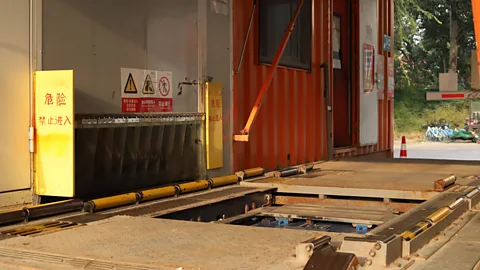At a battery swap station near the Beijing Olympics Sports Centre, the owner of a Nio car watches as a fully charged battery is placed into his vehicle. The station’s staff drive his car onto a platform with an integrated system which removes the depleted battery from beneath the car and loads it a fresh one. The whole process takes no more than five minutes.
Behind him, a few other customers wait in line under an overcast sky, the iconic Bird’s Nest Olympic stadium not far in the distance. Outside the battery swap station, a slogan reads, “Battery swap stations are equivalent to gas stations for electric vehicles”.
Battery swapping – which simply means changing out depleted electric vehicle (EV) batteries for fresh, recharged ones – is an alternative to charging batteries inside the vehicle, as is used for the vast majority of the world’s electric cars.
China has been able to widely promote battery swap stations so quickly since it is home to the main lithium-ion battery manufacturers – Yihao Xie
While battery swap is still largely a nascent sector, China has the world’s most developed model by far. While it’s mainly used for larger vehicles – close to half of the electric heavy-duty trucks sold in China in 2023 were equipped with battery-swap technology – the country is also seriously experimenting with swaps for personal cars.
Chinese electric vehicle company Nio has now built over 3,300 battery swap stations in China, while Catl, China’s (and the world’s) largest EV battery producer, recently announced plans with oil giant Sinopec to build a “battery-swapping ecosystem across the whole nation”.
Battery swapping can have some big advantages, in particular the lower amount of time it takes compared to recharging a battery while its inside a car. Still, it faces obstacles in China, which is also developing fast charging infrastructure at breakneck speed.
In fact, experts say that it may be in the countries which, unlike China, remain in the early stage of a switch to EVs that battery swaps prove most useful for supporting electric car uptake – especially when it comes to addressing range anxiety among drivers.
 Iris Liu
Iris LiuEspecially during the early days of electric vehicles, they were difficult to promote on a large scale due to range anxiety, says Daizong Liu, East Asia director of the Institute for Transportation and Development Policy (ITDP) in New York. A lack of charging facilities led to longer waiting times and interruptions during trips for EV users. Battery swap technology soon entered the field as a potential solution.
Although first tested and used more than a century ago before electric cars fell out of favour, in more recent decades battery swaps for electric cars were initially picked up by EV battery swap company Better Place, which was established in Israel in 2007. Operating in Denmark and Israel, it aimed to reduce the cost of batteries as well as reduce range anxiety and charging times, and received almost $1bn (£760m) in funding. But the company eventually went bankrupt in 2013, citing difficulties in consumer adoption and securing sufficient support from automakers, the Times of Israel reported at the time.
Just weeks after Better Place declared bankruptcy, Tesla’s plans to launch its own 90 second battery swap service were widely reported, with initial swapping locations along routes between Los Angeles and San Francisco, and Boston and Washington. But just two years later, it began phasing swapping out again, citing low market acceptance.